Quote
Hi @all, It’s me again and It’s been a while after I chill out and enjoy the technologies, so I turn back and today I will talk about
Vault, Identity Server likeKeyCloakwhich provideOIDCAuthentication methods for accessing Vault, How can we use this combination for rotating vault token. One more time, happy to see you here and now let’s digest what we got today 🙌
Problem and What things do we have ?
Quote
First of all, as usual we will try to walkthrough a bit concept, technologies and moreover situation of this articles, it will help you why we should order and combine
vaultandkeycloakfor your service
Hashicorp Vault - Secrets Management
Info
What is Vault
Vault is an identity-based secret and encryption management system. It’s a product of Hashicorp, same providers of
Terraform,Vagrant,Nomad, …
If you want to find the optional for your secrets management, Vault is great options for your choice, because It provides us what a features, such as
-
Secrets Management: Centrally store, access, and deploy secrets across applications, systems, and infrastructure.
-
Encryption Service: Securely handle data such as social security numbers, credit card numbers, and other types of compliance-regulated information.
-
Key Management: Use a standardized workflow for distribution and lifecycle management of cryptographic keys in various KMS providers.
In terms of protection, Vault support us for authorization for multiple ways, such as
Quote
It’s been a while when I use
vaultbut not much for understanding whole of feature of this platform, so we can turn back later in another blog and go detail of incredible tools.
But talk about what I like most about Vault, honestly you should talk about methodology Vault supplies for authenticating with multiple platform and access to Vault for getting secrets. Currently, Vault support authentication via
- Auth Method:
userpass,kubernetes,jwt,oidc, … - Tokens:
token
It makes Vault to become more flexible than multiple tools with various platforms can make connect and compatible with Vault to become consistent. It’s not bad to say “Vault is a great option for you in currently, as OpenSource (Self-hosted Version)“
Why I told, Vault is great choice because It has huge community, support SDK in multiple languages and have CLI for who want to stick with this platform
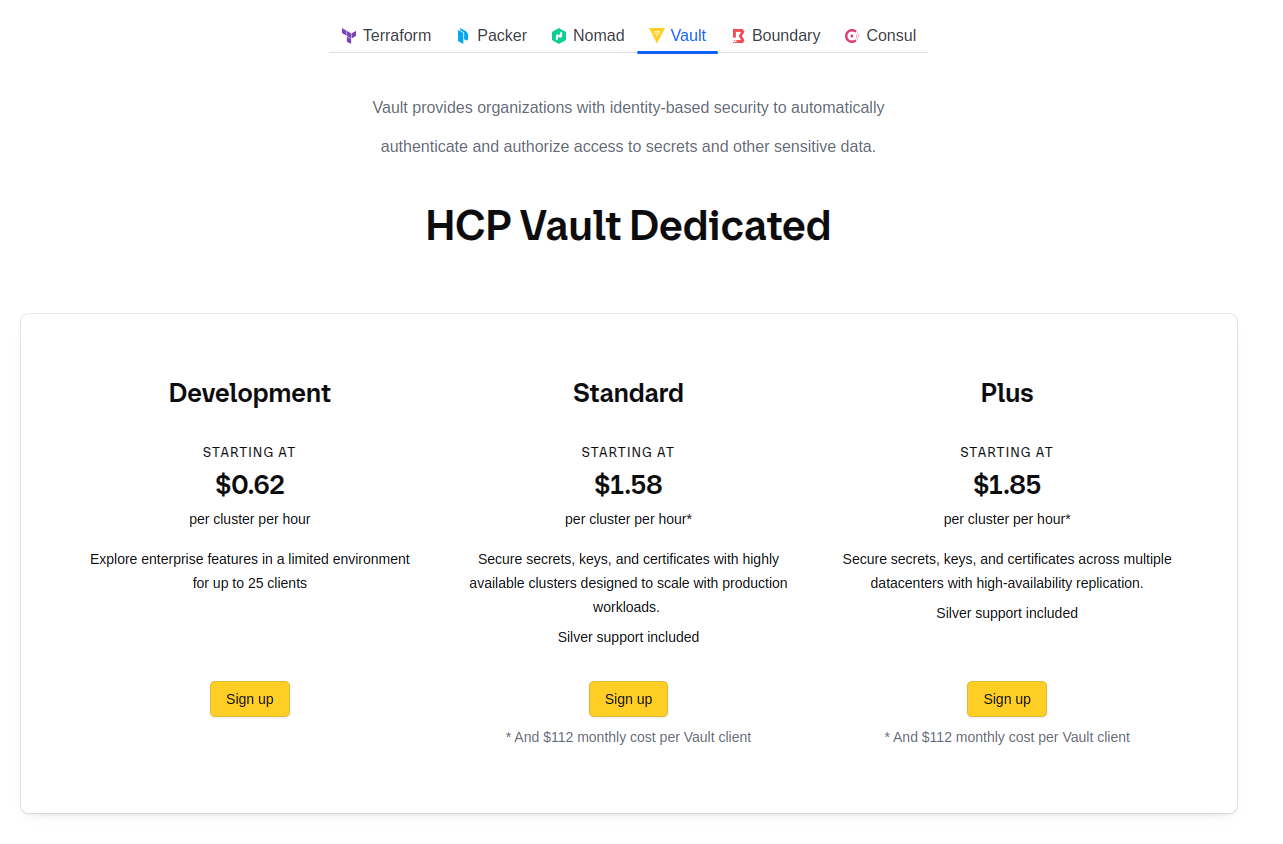
But here is the deal, if you want to work with Vault because this platform has multiple to usage via
- Hashicorp Vault - Cloud: It will cost you around 0.62$ for hour of Cluster (Too expensive 🥶)
- Hashicorp Vault - In your host: Totally free and support for multiple OS
- Hashicorp Vault - Docker: Free and should be used via Docker 😄
- Hashicorp Vault - Kubernetes Helm: Deploy your
Vaultvia Kubernetes and use a couple of massive features, truly crazy stuff and unique - If you find a cloud supportive, AWS and Azure
Quote
So I promise if we have occasion, I will write a blog to guide you about how to selfhosted vault for your own. But now, make sure you try self-hosted Vault for your own.
But hold on, wait a sec, There are many tools out there can become actual rival of Vault, you can find more of them, like
- infisical: the open-source secret management platform
- sops : Simple and flexible tool for managing secrets
- openbao: An open source, community-driven fork of Vault managed by the Linux Foundation.
KeyCloak - Identity Server for y’all
Quote
I try to refer to Vault with
OIDC/JWTas authentication method, right ? It means you need identity servers where help you authentication viacallbackfunction to login from this one into Vault, andKeycloakbrings back the solution
Quote
What is KeyCloak
Keycloak is an Open Source Identity and Access Management For Modern Applications and Services - a single sign on solution for web apps and RESTful web services. This one is one of popular projects managed by CNCF
Keycloak supports user multiple features, such as
- Single Sign On (SSO)
- Identity Brokering and Social Login
- User Federation
- Standard Protocol such as OpenID Connect, SAML and OAuth 2.0
- …
Let’s talk a bit about KeyCloak Architecture, but the documentation It’s quite hard to read and following concept, so you can read add-on articles or read server-admin of KeyCloak 😃, such as
- Dev.to - Getting Started with Keycloak: Understanding the Basics
- KeyCloak - Server Administration Guide
- KeyCloak Benchmark - Architecture
If you run KeyCloak in Kubernetes, you will usually see that exist two components, including
- KeyCloak Server: It’s only KeyCloak runtime and core processor for whole tasks you work with KeyCloak via API, UI or SDK
- KeyCloak Database: If you run
KeyCloakas production, It’s actual recommend you run with Database andPostgreSQLis one of databases choice byKeyCloak
With Keycloak, you will approach with couple of concepts, like
Realm: A realm manages a set of users, credentials, roles, and groups.roles: Roles identify a type or category of userconsent: when you as an admin want a user to give permission to a client before that client can participate in the authentication process
For Installation KeyCloak, you will have multiple ways, and run with database is best practice to keep your data with KeyCloak
- KeyCloak - OpenJDK: Installation from binary version
- KeyCloak - Docker: Docker version KeyCloak, You need
dockerto hit and run - KeyCloak - Kubernetes Manifest: Use Kubernetes Manifest to deploy KeyCloak
- KeyCloak - Kubernetes Helm: Use Kubernetes Helm to deploy KeyCloak. Managed by Bitami
- KeyCloak - Kubernetes Operator: Use Kubernetes Operator to deploy KeyCloak. Guide
Quote
One time again, We don’t have much time to go through detail about
KeyCloak, I will keep that for individual blog becauseKeyCloakis really huge and you should give bunch of time to use and gain experience with KeyCloak
But KeyCloak is not unique things about Identity Server, This category have at least 5 - 10 candidates as actual rival of KeyCloak, like
- authentik : An IdP (Identity Provider) and SSO (single sign on) that is built with security at the forefront of every piece of code, every feature, with an emphasis on flexibility and versatility.
- spicedb: Open Source, Google Zanzibar-inspired database for scalably storing and querying fine-grained authorization data. Documentation
- FusionAuth: a modern platform for Customer Identity and Access Management (CIAM).
- zitadel: Identity infrastructure, simplified for you.
- authelia: The Single Sign-On Multi-Factor portal for web apps
- hydra: Fully customizable OpenID Certified™ OpenID Connect and OAuth2 Provider in the world.
- Moreover at OIDC, Authentication, …
The Actual Problem

So turn back to the real story, It is about how can we solve problem when you need rotation your Token for couple of reasons
- Renew
TTLbecause Vault lets you borrow the token as lease state, It means afterTTLreach to expire, your token will revoke and It can cause corrupt your work progress. - Secure your application and your authentication, It grants you specific policies on the right
audand suitablettl
For practice with vault, you can use multiple ways to authentication and it give a couple of ideas and that why you can see I bring keycloak with vault.
- Use
OIDCwith tools for access by automation test tools, such as selenium or playwright, authorized bykeycloakand generate Vault Token - Use
jwttoken to authentication, authorized bykeycloakand generate Vault Token - Use
userpassto authentication to Vault and generate Vault Token
You can follow a couple of articles to understand why
- Youtube - Configure OIDC access to Vault in Less than 10 Minutes!
- Medium - Vault + Keycloak: Secure JWT-Based Access
- Vault - Use JWT/OIDC authentication
- Medium - SSO Authentication with Selenium
- Dev.to - Automating Zerodha Login without Selenium: A Pythonic Approach
- Medium - Integrating Keycloak OIDC with HashiCorp Vault HCP: A Terraform Comprehensive Guide 🧑💻
Practice Session
Question
In this practice session, we will try follow the strategy to login vault via
oidc/jwtand I will show you how can we setup and configuration for authentication with these method. We can use Python for write a code to try a couple of method idea above

Preparation
First of all, you should install vault-cli in your host, you can follow this code to get stable version
https://releases.hashicorp.com/vault/1.18.5/vault_1.18.5_linux_amd64.zip && unzip vault_1.18.5_linux_amd64.zip && sudo mv vault /usr/local/bin && rm -rf vault_1.18.5_linux_amd64.zip LICENSE.txtNext you need to configuration KeyCloak with a couple of steps to follow or tutorial
- Access into your
keycloak, I recommend usemasterrealms for add another realm into your host - After, you create realms, such as
vaultfor example, you can go toclientand create new one
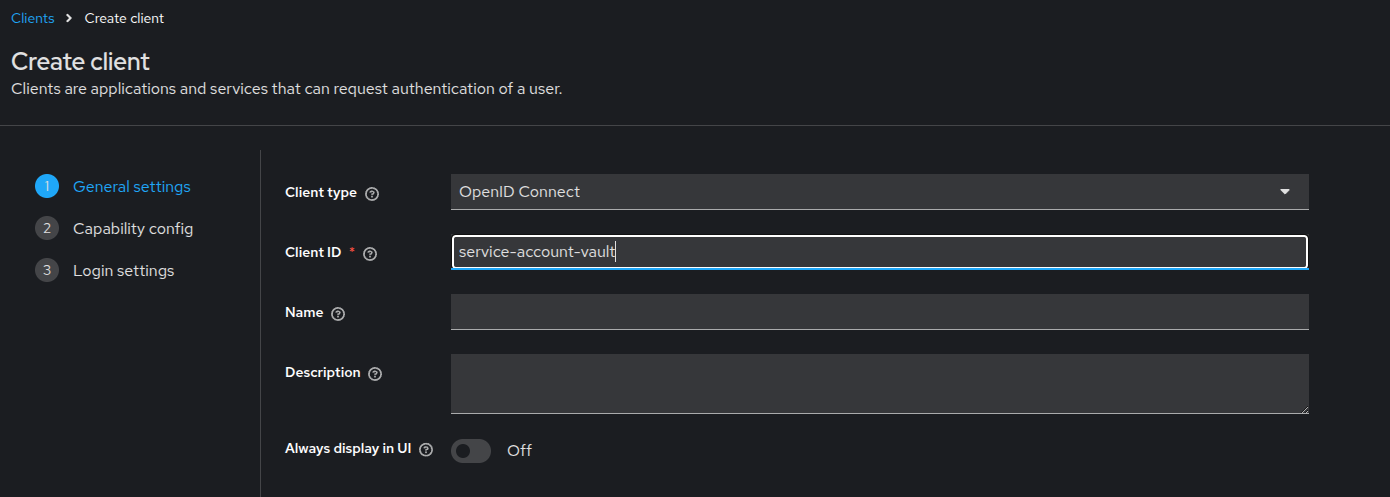
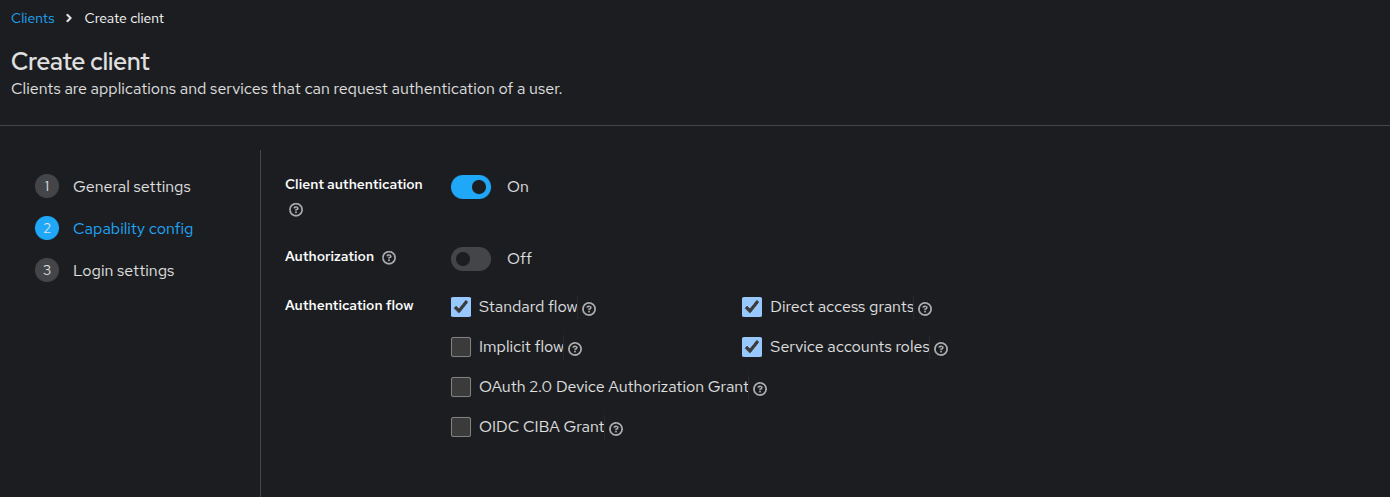
-
In Login Settings, you can put into textbox follow your Vault Host
- Root URL: Your Vault Host, e.g:
http://localhost:8200 - Valid redirect URIs:
http://localhost:8200/ui/vault/auth/oidc/oidc/callbackandhttp://localhost:8250/oidc/callback - Admin URL:
http://localhost:8200/ui/vault/auth/oidc/oidc/callback
Explain:
- If you use UI, your callback URL will return from
localhost:8200so if you map domain, you should exchange intolocalhost:8200intovault.test.comfor example - If you use CLI, your callback URL will return from
localhost:8250so It will return via CLI atlocalhost:8250, It means you not need map it to any domain because it only work on withvault-cli. Or if you want to usedomain, make sure it have pathoidc/callbackto handle this response
- Root URL: Your Vault Host, e.g:
-
Get your client secrets and we will done with
keycloak
Vault with OIDC and JWT
Info
To enable
OIDC/JWTin Vault, you can use with both version UI or CLI, I prefer UI because you can create and configuration directly via this tools than UI (NOTE: some functionality can configure only via CLI, If you want to use UI, you can use atCLIsymbol)
To setup and enable, you need to export environment for VAULT configuration
- VAULT_ADDR=“your-vault-address”
- VAULT_TOKEN=“root-token-plz”
Now enable oidc and jwt via command
# default
vault auth enable jwt
vault auth enable oidc
# if you want to more specific path
vault auth enable oidc -path keycloak # Your OIDC will use /keycloak pathWarning
if you set path in your auth method, you should be exchange your URL in UI configuration to specific to mount directory, e.g:
/keycloak
- UI Path:
https://{vault_host}/ui/vault/auth/keycloak/oidc/callback- Template:
https://{host:port}/ui/vault/auth/{path}/oidc/callback
Next, configuration profile for oidc and jwt
oidc
vault write auth/oidc/config \
oidc_discovery_url="https://{your-keycloak-host}/realms/{your-vault}" \
oidc_client_id="{your-client-name}" \
oidc_client_secret="{your-client-secret}" \
bound_issuer="https://{your-keycloak-host}/realms/{your-vault}" \
default_role="default"jwt
vault write auth/jwt/config \
oidc_discovery_url="https://{your-keycloak-host}/realms/{your-vault}" \
oidc_client_id="" \
oidc_client_secret="" \
bound_issuer="https://{your-keycloak-host}/realms/{your-vault}" \
default_role="default"There are two situations for configuration jwt, including
- To support JWT roles, either local keys, JWKS URL(s), or an OIDC Discovery URL must be present. For OIDC roles, OIDC Discovery URL, OIDC Client ID and OIDC Client Secret are required. For the list of available configuration options, please see the API documentation.
- If you need to perform JWT verification with JWT token validation, then leave the
oidc_client_idandoidc_client_secretblank. (This is my situation)
Next, role profile for oidc and jwt. You should read OIDC Configuration to understand more about role
oidc
vault write auth/oidc/role/default \
allowed_redirect_uris="https://{vault-host}/ui/vault/auth/oidc/oidc/callback" \
allowed_redirect_uris="http://localhost:8250/oidc/callback" \
user_claim="sub" \
ttl="1h" \
role_type="oidc" \
policies="your-policies"jwt
vault write auth/jwt/role/default \
allowed_redirect_uris="http://localhost:8250/oidc/callback" \
bound_subject="your-bound-subject" \
bound_audiences="your-bound-audience"
user_claim="sub" \
ttl="1h" \
role_type="jwt" \
policies="your-policies"For understand about claim, you should read about Bound claims
bound_subject: must match the providedsubclaim (In yourjwttoken)bound_audiencesparameter is required when anaudclaim is set.bound_audiencesparameter must match at least one of providedaudclaims.
But how to understand the structure of jwt token generate about KeyCloak, you should read these articles
- Platformatic - Configure JWT with Keycloak
- KeyCloak - Authorization Services Guide
- Dev.to - How To Configure Audience In Keycloak
Now define the policies, and you can kickoff your login with oidc/jwt
vault policy write your-policies <<EOF
path "secret/data/test/*" {
capabilities = ["read"]
}
EOFRemember create kv secret engine with name secret and provide PATH /data/test
Alright, now you can login Vault with OIDC/JWT
Login Vault with CLI and UI
If you choose UI for login option, your page will return this
OIDC
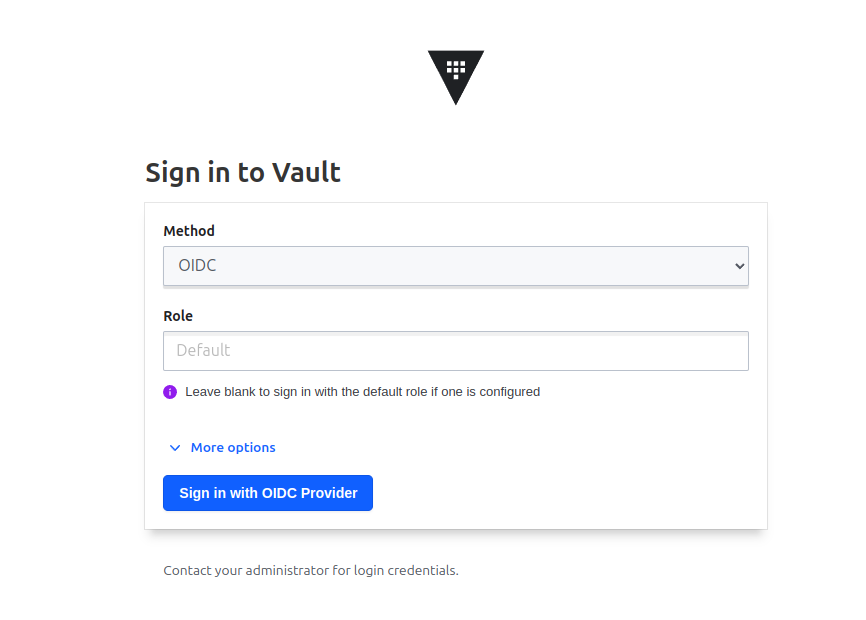
JWT
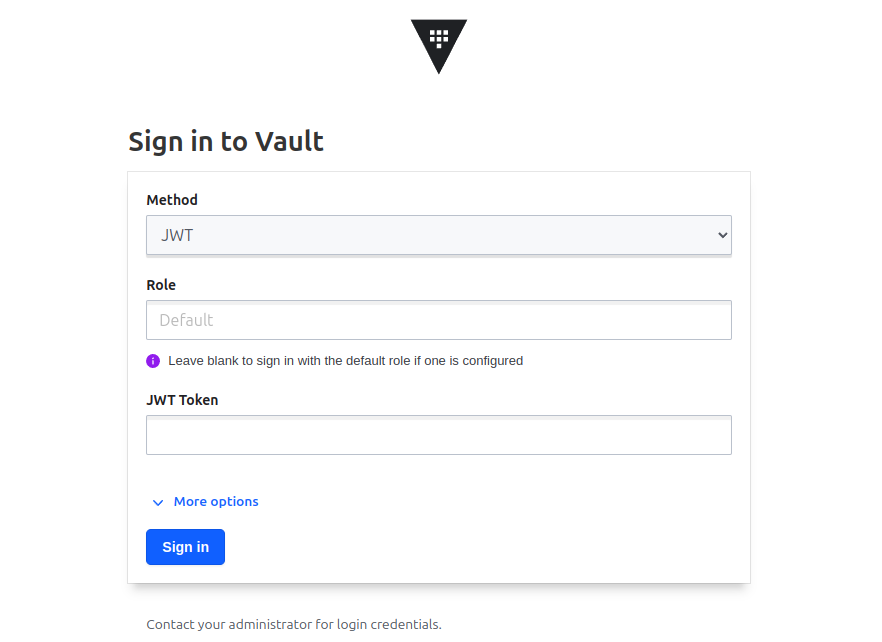
If you choose OIDC, It will pop up and return you a page of keycloak for callback functionality, login with username and password in that realms and you can directly login into Vault
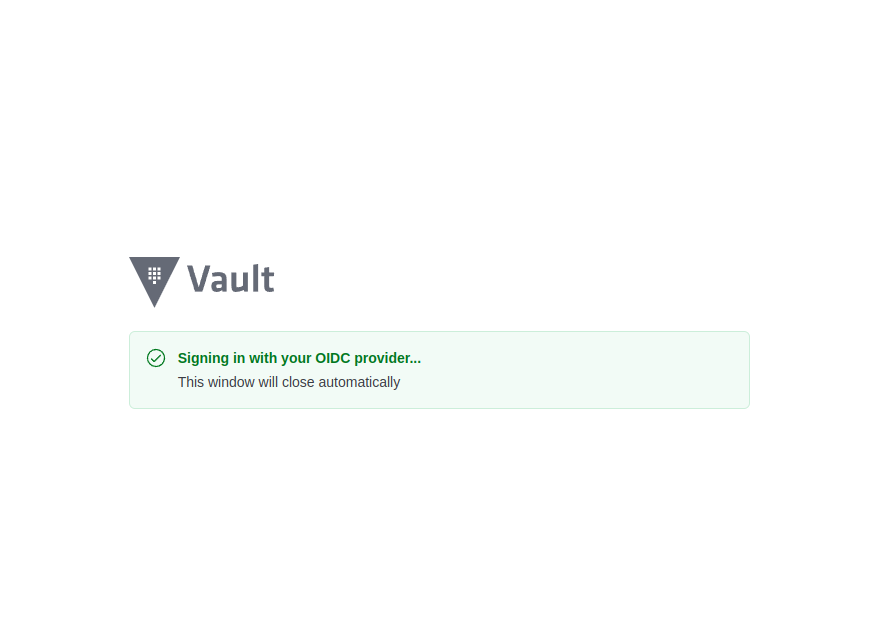
What else if you use CLI for authentication, It’s same as UI but it operate via CLI 😄
vault login -method=oidc role="default"This command will return vault-token, you can use for long-term purpose but now your host will authentication into Vault
JWT only supports for validate your JWT Generated, so you need to use API or SDK to help you generate it via KeyCloak. So we will move to authentication via Python and use hvac to tackle this option
Use Python for Authentication
Quote
First of all, I want to talk a bit about my stupid plan, use automation test tools for automatically login as OIDC providers. It’s actually to say I fail but that kinda fun idea to help we can login with used
seleniumorpypeeteerto run chrome as headless mode to login via browser running in background. But it’s hard to control because you need to programming as asynchronous to sort of task via thread. If you wanna try, go ahead because I curious how can I do it for production 😄
To make a code run, you should install couple of library
hvac==2.3.0
requests==2.32.3The success optional is one used to render jwt token and login into vault via this. You can follow this python
import requests
import hvac
client = hvac.Client("https://vault.example.xyz")
ROLE = 'default'
KEYCLOAK_URL="your-keycloak-url"
KEYCLOAK_REALM="your-realm"
KEYCLOAK_CLIENT_ID="your-client-id"
KEYCLOAK_CLIENT_SECRET="your-client-secret"
KEYCLOAK_USERNAME="your-keycloak-username"
KEYCLOAK_PASSWORD="yout-keycloak-password"
token_url = f"{KEYCLOAK_URL}/realms/{KEYCLOAK_REALM}/protocol/openid-connect/token"
data = {
"grant_type": "password",
"client_id": KEYCLOAK_CLIENT_ID,
"client_secret": KEYCLOAK_CLIENT_SECRET,
"username": KEYCLOAK_USERNAME,
"password": KEYCLOAK_PASSWORD,
}
response = requests.post(token_url,data=data)
# print(response.elapsed.total_seconds())
token_data = response.json()
# print(token_data['access_token'])
response = client.auth.jwt.jwt_login(
role=ROLE,
jwt=token_data['access_token'],
)
print('Client token returned: %s' % response['auth']['client_token'])The code will split into two progress
- Request to
keycloakto generateJWTtoken, usedrequests - Sending the
jwtfromkeycloakto Vault withROLE, and result will returnclient_tokenof vault, usedhvacto create client_connection
The failure, you can read about example - OIDC Authorization URL Request to understand what they do. I will try to brief this one depend on my knowledge
- In a head of script, they try to define the callback_url with port, as you can remember that one same as
vault-clirequired, so default it should be port8250. One more they define the closing page for help your return into your browser if you login successful - In
login_oidc_get_tokenfunc, they try to define HTTP Server which run and handle request from browser about your login, It will listen inlocalhost:8250for your login become success - In
mainfunc, they will getcallbackurl and open browser to redirect you to thatkeycloaklogin page, after you login successful they will uselocalhost:8250to turn backHTMLdefinition with parameter attaching. They try to gettokenforlogin_oidc_get_tokento make authenticate into vault withtoken,nonce,stateretrieve fromcallback_url - At the end they return
client_tokensame asjwtway
But, I want to automatically this functionality so why I make decision for use playwright to login with chrome headless version. So I’m not good to code async because I don’t have much experience with this, but use gemini and I got this
import asyncio
import hvac
import urllib.parse
from playwright.async_api import async_playwright
from http.server import BaseHTTPRequestHandler, HTTPServer
import threading
import logging
OIDC_CALLBACK_PORT = 8250
OIDC_REDIRECT_URI = f'http://localhost:{OIDC_CALLBACK_PORT}/oidc/callback'
ROLE = 'default'
# SELF_CLOSING_PAGE = '''<!doctype html><html><head><script>// Closes IE, Edge, Chrome, Bravewindow.onload = function load() { window.open('', '_self', ''); window.close();};</script></head><body> <p>Authentication successful, you can close the browser now.</p> <script> // Needed for Firefox security setTimeout(function() { window.close() }, 5000); </script></body></html>'''
SELF_CLOSING_PAGE = '''
<!DOCTYPE html>
<html>
<head>
<title>Authentication Successful</title>
</head>
<body>
<p>Authentication successful. You can close this tab now.</p>
</body>
</html>
'''
logging.basicConfig(level=logging.DEBUG)
async def login_oidc_get_token_playwright(auth_url):
"""Uses Playwright to automate the OIDC login process."""
class HttpServ(HTTPServer):
def __init__(self, *args, **kwargs):
HTTPServer.__init__(self, *args, **kwargs)
self.token = None
self.event = threading.Event()
self.error = None
class AuthHandler(BaseHTTPRequestHandler):
def do_GET(self):
try:
params = urllib.parse.parse_qs(self.path.split('?')[1])
self.server.token = params['code'][0]
except Exception as e:
logging.error(f"HTTP Server Error: {e}")
self.server.error = e
finally:
self.server.event.set() # Event is always set
self.send_response(200)
self.end_headers()
self.wfile.write(str.encode(SELF_CLOSING_PAGE))
server_address = ('', OIDC_CALLBACK_PORT)
httpd = HttpServ(server_address, AuthHandler)
def run_server():
try:
httpd.handle_request()
except Exception as e:
logging.error(f"Server Thread error: {e}")
httpd.error = e
finally:
httpd.event.set() #event is always set
httpd.server_close()
server_thread = threading.Thread(target=run_server)
server_thread.start()
async with async_playwright() as p:
browser = await p.chromium.launch(headless=False)
page = await browser.new_page()
await page.goto(auth_url)
await page.wait_for_selector('#username')
await page.fill('#username', 'your-username')
await page.fill('#password', 'your-password')
await page.click('#kc-login')
await page.wait_for_url(url=OIDC_REDIRECT_URI, wait_until="load")
# await browser.close()
logging.debug("Playwright finished, waiting for server...")
await browser.close()
logging.debug("Browser closed successfully.")
if not httpd.event.wait(timeout=30): # Timeout after 30 seconds
logging.error("Timeout waiting for HTTP server.")
return None
if httpd.error:
logging.error(f"HTTP Server error: {httpd.error}")
return None
logging.debug(f"Token received: {httpd.token}")
server_thread.join(timeout=5) #added timeout to thread join.
logging.debug("Server Thread finished")
return httpd.token
async def main():
client = hvac.Client("https://vault.example.xyz")
auth_url_response = client.auth.oidc.oidc_authorization_url_request(
role=ROLE,
redirect_uri=OIDC_REDIRECT_URI,
)
auth_url = auth_url_response['data']['auth_url']
if auth_url == '':
return None
params = urllib.parse.parse_qs(auth_url.split('?')[1])
auth_url_nonce = params['nonce'][0]
auth_url_state = params['state'][0]
token = await login_oidc_get_token_playwright(auth_url)
if token is None:
return None
auth_result = client.auth.oidc.oidc_callback(
code=token,
path='oidc',
nonce=auth_url_nonce,
state=auth_url_state,
)
new_token = auth_result['auth']['client_token']
logging.debug(f'Client token returned: {new_token}')
client.token = new_token
return client
if __name__ == '__main__':
asyncio.get_event_loop().run_until_complete(main())This code is not completely, if you have any idea, it should be considered for implementing. Cheer 1 hour of mine exhausted with gemini to deal with it
Remember install playwright before playing around with above script
pip install playwright
playwright installConclusion

Success
That’s all for this weekend, hope you walkaround to the end of session and find well with your implementation. It’s kinda curious and fun, I have time to learn again who been as dev for implementation, learn and share with you about couple of idea that’s crazy enough. But don’t deal with your production, let’s keep it simple 🍻
Quote
Feel great and enjoyable with mywork, I’am super curious with whole things I learn from my job, that give me more advice and ability to brain storm and deal with crazy idea, like run headless for authentication OIDC, that’s really fun. So stay safe, keep working and learning y’all guy and we will meet together on next weekend. Bye and have happy weekend !!!
